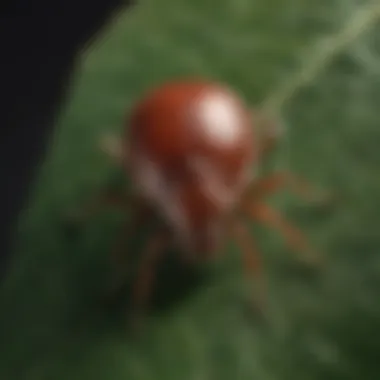Effective Strategies for Treating Ticks in Your Home


Overview of the Topic
Ticks represent a growing concern in households around the world. These small, blood-sucking arachnids are not just pests; they are vectors for numerous diseases, including Lyme disease and Rocky Mountain spotted fever. Understanding how to treat and prevent tick infestations in a home is crucial for protecting both human and animal health.
Ticks thrive in moist environments, attaching to hosts as they pass by, and they can be very difficult to deal with if not addressed swiftly. Not only are their bites irritating, but the health risks associated with tick-borne illnesses are substantial. As awareness of these issues increases, it is important for homeowners to be a step ahead in integrating effective methods for control.
Current Status and Challenges
As urban areas expand, the relationship between the environment and human habitation changes. Tick populations are on the rise, propelled by climate change, habitat destruction, and the encroachment of wildlife into urban settings. Understanding the current status of tick infestations helps homeowners realize the real threat ticks pose.
One major challenge in mitigating tick infestations is identifying them early. Though they are small, their presence is not easily detectable unless one knows what to look for. Their natural hideouts, dense vegetation and leaf piles, are commonly found in backyard ecosystems. Homeowners must learn to monitor these surrounding environments carefully to devise a timely response.
Sustainable Solutions
Communities and individuals alike must adopt sustainable solutions to effectively manage ticks. Here are some practices to consider:
- Regularly mow grass and trim shrubs to prevent overgrown areas where ticks reside.
- Keep yard debris, such as leaf piles, to a minimum. Ticks thrive in such areas, so regular cleaning is essential.
- Introduce native landscaping, which can reduce tick habitats by allowing for environmental balance.
Implementing these yard management strategies not only targets tick populations but benefits entire ecosystems. Success stories include integrated pest management programs that employ the use of natural predators and pesticides derived from plant sources, thus minimizing chemical exposure to humans and pets.
Impact and Importance
Ticks have a profound impact that transforms local ecosystems and human communities. Every year, tick bites lead to numerous illnesses. Some people may suffer long-term effects or complications from tick-borne diseases, making education on this topic imperative.
It is critical to realize the importance of ongoing management practices and prevention measures. As communities learn more about sustainable practices and the balance of nature in their backyards, overall health improves. Using eco-friendly resources also proves vital for future generations, maintaining a realistic strategy to avoid unnecessary chemical harm.
"Understanding ticks and their behaviors is essential. Every effort, no matter how small, contributes to a larger solution."
Being informed and undertaking responsible actions allows for a shift that could potentially decrease tick populations, thus cultivating a safer, healthier home environment for all residents.
Understanding Ticks
Ticks are small arachnids that pose significant risks to both human and animal health. Gaining an understanding of ticks is fundamental to managing their presence in living spaces. Knowledge about ticks, their life cycles, and their habitat preferences helps homeowners identify suitable treatment methods and preventive strategies. The implications of tick infestations are far-reaching, involving public health concerns that necessitate thorough awareness and action.
The Nature of Ticks
Identification of Common Tick Species
Proper identification of tick species is essential for effective control. Various species exist, such as the deer tick (Ixodes scapularis), which is common in certain areas of the U.S. Identifying the species is critical because each has different behaviors and disease transmission capabilities. Knowing the key features of ticks, such as shape and color, assists in distinguishing them visually. This understanding may lead to quicker and more accurate responses when dealing with infestations or preventative measures.
Life Cycle of Ticks
Ticks undergo several developmental stages, including larva, nymph, and adult. Each stage requires blood meals to transition to the next, thus making them a health risk at every point in their life cycle. Understanding this cycle is valuable in timing treatment and identifying optimal moments to reduce tick populations. For example, during nymph stage, ticks are most likely to consume blood from larger hosts. This suggests that monitoring should peak at this time to mitigate exposure risks.
Habitat Preferences
Ticks prefer moist environments with ample vegetation, which provide essential conditions for shelter and humidity. These attributes make tall grasses and bushy areas ideal habitats. Recognizing these preferences allows homeowners to modify their surroundings, reducing suitable environments for ticks. For example, regular lawn maintenance and trimming bushes can ultimately disrupt the cycle of ticks.
Health Risks Associated with Ticks
Diseases Transmitted by Ticks
Ticks are renowned vectors of numerous diseases, such as Lyme disease and Rocky Mountain spotted fever. Understanding the range of diseases enables individuals to recognize both risks and symptoms quickly. This knowledge emphasizes the importance of targeting tick control measures effectively. Each tick species can transmit specific pathogens; therefore, learning these associations aids in risk assessment and informed decision-making about house treatments.
Symptoms of Tick-Borne Illnesses


Recognizing symptoms early can be life-saving. Common signs of tick-borne illnesses include fever, chills, fatigue, and in advanced cases, joint pain. As the manifestation of symptoms can vary, aware and informed individuals can seek medical assistance if necessary. This underscores the importance of understanding ticks and their associated health ramifications, moving beyond just environmental concerns.
Preventive Health Measures
Adopting preventive health measures is key to management and reduces exposure risks drastically. These measures may include wearing protective clothing and employing tick repellents when spending time outdoors. Knowledge in these areas contributes to fostering safer environments. Furthermore, continuous education regarding prevention provides robust perspectives on safeguarding personal health and that of one's family.
Identifying Tick Presence in the Home
Identifying tick presence in the home is crucial for maintaining a healthy living environment. Ticks can easily infiltrate households, making it essential for homeowners to be vigilant about potential infestations. Early detection can mitigate health risks posed by these arachnids, such as Lyme disease and other tick-borne illnesses. Understanding how to spot ticks and their signs helps to secure your living spaces from these pests, contributing to the overall welfare of both humans and pets.
Signs of Tick Infestation
Visual Inspection Methods
Visual inspection methods are vital for identifying tick presence in your home. Conducting thorough inspections by visually examining various nooks and corners can reveal if ticks have settled in. A key characteristic of this method is its simplicity; anyone can perform a visual inspection without extra tools or training. This low-cost and easily accessible approach allows for consistent monitoring of high-risk areas.
Unique to visual inspection is the ability to quickly gather information. Observing specific signs such as shed skin and tick feces can provide insight into an infestation's extent. However, there are limitations, as ticks are small and may be easily overlooked, especially in dense fabrics or enclosed spaces. This method may require patients and careful attention to detail.
Behavioral Indicators from Pets
Behavioral indicators from pets serve as invaluable clues indicating potential tick infestation. Pets can exhibit changes in behavior, such as excessive scratching, biting at their bodies, or unusual restlessness. Dogs and cats are often the first to interface with ticks when roaming outdoors. Notably, monitoring these behavioral changes can save owners from the consequences of an undetected tick problem.
One profound characteristic of using pets as indicators is their interaction with the environment; they may harbor ticks in their fur even when unaffected by infestations nearby. Check for signs of ticks long before they manifest in humans. However, pet behavior can fluctuate for many reasons unrelated to ticks, such as allergies or skin conditions. Therefore, it becomes necessary to supplement observations with more rigorous tick-checking protocols.
Common Areas for Tick Hiding
Common areas for tick hiding present crucial focal points in the overall battle against tick presence in homes. Ticks generally prefer moist environments and areas with ample hosts. Knowing where ticks typically reside — like carpets, bedding, or inside closets — can enhance your ability to identify infestation early. This not only points to areas that may need extra attention but also helps homeowners understand the behavior of these pests better.
A fundamental characteristic of these hiding spots is their often overlooked nature; spaces tucked out of sight are often neglected, leading to unnoticed tick populations. The unique feature of these common areas is that they are usually spots where people and pets inhabit most frequently. Verbose cleaning and inspections can help mitigate their chances. Despite being effective focal points for inspection, it may require consistent monitoring to keep these areas optimized.
Tick Inspection Protocols
Inspecting Living Spaces
Inspecting living spaces is one of the most essential protocols in identifying ticks at home. By systematically scanning every room for signs of tickets, individuals can effectively reduce infestations. This protocol emphasizes a proactive approach. Developing routines encourages regular check-ups instead of delayed inspections.
The key characteristic of this method is detailed scrutiny. One can take notes or even maintain a checklist for thorough inspections, ensuring that none of the critical areas is ignored. Particularly, looking in dense carpets, between furniture, or behind curtains can yield results. However, this protocol also requires a certain level of meticulousness and time commitment.
Checking Belongings and Clothing
Checking belongings and clothing regularly is an essential element in effective tick management. This inspection method helps in catching ticks that may hitchhike home from outdoor environments. Belongings taken from places with high tick exposure should receive special attention.
The main characteristic of this strategy lies in its practicality. Regularly inspecting items such as backpacks, jackets, or outdoor gear minimizes the chance of carrying ticks into the home. The unique aspect is that the proactive detection of ticks stops before they can access living spaces. Nonetheless, if this method is overlooked, it might undermine more extensive inspections.
Regular Checks for Pets
Regular checks for pets provide solid defenseless against ticks making themselves comfortable in your home. Regular inspections, especially after outdoor activities, can reveal tick attachment points, ensuring pets do not transport them. This method is beneficial for both pets and humans, as educating pet owners on the importance of routine checks promotes communal well-being.
An important characteristic is that this approach helps in cutting down tick populations before they infiltrate human habitats. The advantage of conducting examinations slowly allows for thorough searches, thereby preventing overlooking ticks that can irritate a pet. Unbeknown to many, having pets face the issue of ticks increases prior ownership of knowledge about carrying other unwanted insects inside.
Methods to Treat Ticks Inside the Home
Dealing with ticks inside the home is a substantial concern for many. Their presence not only causes distress but also exposes the home’s inhabitants to health risks. Effective treatment methods form the backbone of any strategy aimed at addressing infestations. They are essential for restoring peace and ensuring a safe environment. Choosing the right combination of these methods can greatly enhance the efficacy of treatment. Each approach comes with its own set of benefits and considerations, making a balanced perspective crucial.
Chemical Treatments
Understanding Pesticides


Pesticides are chemical substances specifically designed to eliminate pests, including ticks. Knowledge of their characteristics is vital. Certain pesticides, like permethrin and bifenthrin, are commonly used against ticks. They effectively disrupt the nervous system of these arachnids, proving to be a strong deterrent. However, their use requires careful evaluation as they can also impact beneficial organisms. Timing plays an important role. Treatments should coincide with peak tick season for maximum impact. Pesticides can minimize tick exposure in residential areas, but they should be used with proper understanding.
Application Procedures
The application procedures for pesticides demand attention to detail. Proper methods ensure that the treatment is both effective and safe. Generally, it is advised to mist or spray insecticides around likely tick harboring zones, such as floorboards and crevices. A hands-on approach, such as thorough coverage, leads to better results. Regular treatments, usually every few weeks, can help maximize control. This guarantees that any newly hatched ticks or those surviving initial treatments will be targeted.
Safety Precautions
Safety precautions when using pesticides cannot be overstated. They are chemical agents that must be handled with care. Usually, homeowners should use gloves and masks. Limiting the exposure during application and keeping pets and children out of treated areas contribute to safety. As ticks can be shown as a problem, awareness of where and how to apply these agents is as important as the treatment itself. Missteps during application could lead to unwanted health effects. Keeping a keen eye on procedures and careful implementation is recommended.
Natural Remedies for Tick Control
Essential Oils with Repellent Properties
Essential oils, such as eucalyptus and lavender, have been recognized for their ability to repel ticks. Their role as natural deterrents provides a safer alternative to chemical treatments. Many people find them appealing due to their low toxicity profiles. Commonly, these oils are included in sprays. Essential oils release aromas that negatively affect the tick senses. While this method is gentle, it may require more frequent application to maintain efficacy. Some may see it as less potent compared to pesticides, making understanding proper dosing essential.
Homemade Tick Sprays
Homemade tick sprays serve as an economical solution against ticks. Typically made from household items, they allow for easy customization. Ingredients often include vinegar and essential oils, providing versatility. Their mixture can cater to various preferences and sensitivities, giving individuality in the process. However, homemade sprays may result in varying effectiveness, depending on combinations used. It often mandates regular re-application for needed effect, leaving some homeowners looking into more reliable approaches.
Beneficial Insects as Natural Predators
Promoting beneficial insects can provide a unique technique for managing tick populations. Species such as certain spiders and predatory beetles are naturally lethal to ticks. Incorporating them in garden settings effectively assists in reducing tick habitats. To think of ticks as just nuisances overshadows a larger ecosystem context. While establishing such beneficial arrangements largely lies outdoors, it does complement indoor initiatives. However, patience usually is required since beneficial insects may need time to flourish for noticeable impacts.
Ongoing Prevention Strategies
Ongoing prevention strategies are vital in maintaining a tick-free household. Tick control is a continuous process that requires attention and consistent effort. By implementing effective methods to reduce tick presence, homeowners can minimize risk and ensure health for their families and pets. Prevention is often more effective than treatment, emphasizing the importance of these strategies.
Maintaining Tick-Free Indoor Spaces
Regular Cleaning Practices
Regular cleaning practices play an important role in preventing ticks in the home environment. A clean living space reduces areas where ticks may hide. Regularly vacuuming carpets, rugs, and upholstery can help to eliminate both ticks and their eggs.
This practice is widely regarded as beneficial because it promotes an overall hygienic environment. Ensuring that corners and under furniture are also frequently cleaned can significantly decrease tick populations.
However, it is crucial to also remember that any cleaning or decluttering should be done systematically and with proper regard for where debris might be harboring ticks.
Preventive Measures for Pets
Preventive measures for pets significantly contribute to controlling tick populations inside the home. This may entail using tick collars, pet shampoos, and topical treatments designed to repel ticks. Such products are designed to safeguard furry friends who are often outdoors.
Pet preventive methods are appreciated due to their efficacy and ease of application. Regular brushing and inspection of pets after outdoor activities are additional important aspects. This allows for quick removal of any attached ticks before they have the chance to transmit diseases. A potential disadvantage, however, lies in the varying effectiveness of products and potential skin sensitivities in pets.
Utilizing Tick Control Products
Utilizing specialized tick control products adds another layer of prevention for homeowners. These products include sprays and granular treatments made for areas with high tick activity. Before applying any of these treatments, it is imperative to read and understand the directions provided.
These control products are often sought after because they can cover larger areas against infestations effectively. A unique feature of many tick control products ideallly include active ingredients that are environmentally conscious. They offer effective insect control while being considerate of surrounding wildlife and pets. Care should be taken, though, as improper use might lead to health risks or ineffective results in tick control.
Outdoor Management to Reduce Tick Incursions
Managing the outdoor environment is critical to further reduce the possibility of indoor tick incursions. Landscaping choices and outdoor strategies can influence wildlife movement and reduce habitat that is suited for ticks.
Landscaping Techniques


Landscaping techniques focus on altering the environment around a residence to make it less hospitable for ticks. This may include maintaining grass at a shorter height and limiting brushy areas where ticks thrive. Cleaning up leaf litter and wood piles where ticks can hide is also beneficial.
Such techniques are favored because they promote a visually appealing yard while preventing tick infestations. The drawback may be an investment in time and effort to establish the desired landscapes, but the long-term benefits to health and safety can prove worthwhile.
Fencing and Barrier Strategies
Fencing and barrier strategies create physical boundaries and assist in keeping wildlife away from proximate areas. Installing fences can deter rodents and deer, animals that are carriers of ticks. Investing in fencing can protect gardens or children's play areas from animal incursion.
This approach is valuable for providing peace of mind, knowing that ordinary wildlife will be kept at a distance. A possible downside is the initial cost and labor that may be associated with installing these completely functional solutions.
Proper Waste Management
Proper waste management also plays a role in reducing tick environments. Regular disposal of trash and yard waste can eliminate potential tick habitats. Using proper containment methods prevents more pests and maintains cleanliness in outdoor spaces.
Such practices are pivotal in promoting not only tick safety but overall environmental health. Neglecting waste management, however, can lead to ticks thriving in improperly maintained rubbish piles, which creates a forgotten breeding ground.
Professional Assistance and Resources
Engaging with professionals for tick control is crucial in maintaining a healthy living environment. This section illuminates the importance of recognizing when home remedies are insufficient and when expert involvement might be necessary. Effectively addressing a tick infestation is integral not only for health protection but also for long-term mitigation.
When to Hire Pest Control Experts
It's vital to assess the impact of ticks and the level of infestation before deciding on hiring pest control services. In several scenarios, seeking professional help can provide thorough solutions that promote a longer-lasting tick-free environment.
Assessing the Severity of Infestation
Assessing the severity of infestation is fundamental to understanding the necessary response. A clear determination of how many ticks are present allows homeowners to decide if a simple at-home approach suffices or if professionals need to intervene. A significant characteristic here is the rate of tick reproduction, as high populations can become unmanageable quickly without prompt action.
This aspect is beneficial for homeowners as it provides a pressing condition where expert intervention is necessary. Generally, if more than just a few ticks are found, this signifies a possible breeding ground in your home or yard, needing another level approach to eliminate. Uniquely, having professional expertise offers tailored solutions based on specific findings, which enables effective extermination.
Evaluating Pest Control Services
Evaluating different pest control services is an essential task before hiring professionals. Understanding distinctions between companies and their methodologies helps ensure that the treatments match the home environment without harsh chemicals. The complexity of options available underscores the importance of appropriate partner selection in tackling tick issues. The best service providers often have experience dealing with ticks mainly in residential areas; this knowledge proves vital for a successful treatment.
A good characteristic of competent pest control services is willingness to consult before signing contracts. This shows a commitment from the provider to crafting a focused plan for your unique circumstances. However, it's essential to consider potential variations in product use; safety should remain a priority, especially for families with pets and children present.
Costs and Effectiveness of Treatments
Cost considerations and treatment effectiveness form a crux in any pest control decision. Treatment costs can vary based mostly on infestation levels and service formulas chosen. Understanding these costs contributes significantly to informed choices, especially if there are pre-existing health risks associated with ticks.
Effective treatments should ideally deliver quick results with ongoing prevention and surveillance strategies. Many companies may offer initial assessments for free or low initial rates—invaluable for gauging your potential expense. Pros and cons generate cogent arguments in pest control choices. Notably, while hiring professionals can incur higher initial costs, their long-term strategies mitigate recurring issues, potentially yielding substantial savings on endless at-home products.
Educational Resources for Further Learning
Continuous education is key for anyone looking to maintain assurance regarding tick control. By utilizing proper resources, homeowners can enhance their understanding and long-term management efforts.
Government Health Websites
Government health websites serve as a prime source for accurate and updated information about tick-related illnesses and preventive measures. Their authority adds value, making them integral to any homeowner’s resource list. Providing a clear understanding of risks connected with ticks, these websites also present preventive strategies at various home and landscape levels.
What sets government resources apart is their reliability and comprehensive nature, which is beneficial during research processes. Choosing these resources leads to evidence-supported practices often aligned with local public health recommendations, although access might vary regarding language use.
Environmental Organizations
Environmental organizations emphasize ecological considerations in tick management, merging community health with ecosystem balance. They are invaluable in raising awareness about tick control efforts through environmental stewardship. Besides strategies for direct tick control, many organizations promote understanding of ecological interactions involving ticks, thereby informing broader pest control methods.
These groups also frequently offer workshops and resources rich with practical community input. This organic-featured support informs efforts to educate families and stakeholders about ticks’ role in broader biodiversity controversies, ensuring that education is interlinked with action, although information can sometimes vary significantly in detail.
Local Extension Services
Local extension services provide tailored assistance specifically adapted to regional challenges with ticks. Their mission focuses primarily on agricultural guidance, but their knowledge includes residential pest control advisement. Accessing local services enriches community members in adapting science-backed resources pertaining to immediate and prevalent issues regarding tick presence.
The distinguishing mark of local extension services is their connection to immediate environments. They can often address context-specific issues contributing to tick safety. Accessibility is an advantage flexible, though adequate outreach efforts need buy-in throughout communities. Understanding local variables will guide more effective long-term tick management while relying on known characteristics specific to communities where tick issues proliferate.



